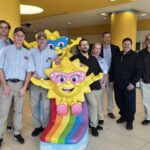 Communication is essential to everyday life ? from the smallest details such as ordering a meal to more complex communications such as collaborating with health care providers. Health care professionals interact and speak with patients about medical issues, health concerns, plans of care and outcomes. They ensure that a patient can ask questions and understand medical issues.
Communication is essential to everyday life ? from the smallest details such as ordering a meal to more complex communications such as collaborating with health care providers. Health care professionals interact and speak with patients about medical issues, health concerns, plans of care and outcomes. They ensure that a patient can ask questions and understand medical issues.
The Americans with Disabilities Act also requires hospitals to provide an effective means of communication with hearing-impaired patients. Ideally, the patient can access interpreting services at a hospital. Interpreting services will help the patient understand and communicate any health-related concerns or questions to a health care provider.
But certified American Sign Language interpreters are few and sometimes far away. In some facilities, health care providers try to compensate by using their own hand gestures, speaking loudly and deliberately, or by writing everything down. Each of these comes with its own difficulties and potential liabilities: not all hearing-impaired patients can read lips or read gestures, and speaking loudly is not an effective means of communication.
To break the sound barrier in the Macon Georgia area, The Medical Center of Central Georgia (MCCG), a 637-bed hospital, is using the video-sign-language interpreting services of DT Interpreting.
The hospital staff can access DT whenever they need it. The portable system is available 24-hours a day, 365 days a year, including holidays, and especially in an emergency, staff can communicate effortlessly with a patient.
“Our patients can rest assured that their health and good outcome is our ultimate goal.”
Liana Rogers,
Interpreting Services Coordinator
The Medical Center of Central Georgia |
The Medical Center began using DT Interpreting in 2002 when the MCCG Auxiliary bestowed a grant to purchase the equipment, and the hospital installed ISDN lines to connect to the DT system. There are currently three units available: one in the main hospital, one in the childrens hospital, and the third in the WT Anderson Clinic.
Liana Rogers, Interpreting Services coordinator at The Medical Center, says, “We need reliability at a moments notice, and ASL interpreters are available by video whenever we need them.
“Video sign language interpreting is an effective tool enabling us to provide quality health care in our hometown. Qualified freelance interpreters are scarce in our service area and the cost of retaining interpreters from the Atlanta area is neither cost effective nor delivered in a timely manner.
| Going Wireless
Video sign language interpreting is experiencing an evolution. Hospitals that use the DT Interpreting system are starting to go wireless.
During the past six months, a number of institutions signed up for wireless and dozens more have expressed interest in learning about the connectivity option.
The system is composed of a portable cart with a Sony IPELA TSC-TL30 teleconferencing unit that includes a monitor, camera and speaker. The system allows an off-site American Sign Language interpreter to be online within minutes, as well as enables deployment of audio-video communications over various hospital networks.
Bob Fisher, president, DT Interpreting, explained that many hospitals “are considering the benefits of wireless connectivity over conventional methods, which have generally involved either ISDN telephone lines or an Internet Protocol infrastructure with an Ethernet hook up both supporting a LANS/WAN environment within a hospital.
“Wireless offers flexibility, efficiently and service. It eliminates the need to plug units into wall outlets or designated sockets a requirement that has restricted the use of equipment to a limited number of hospital locations. Improving upon past capabilities, the new technology lets staff connect a unit incrementally anywhere within the wireless footprint. They can assist patients in more areas of the hospital.”
The cost of going wireless is low — about the same as traditional connectivity methods — and the quality of video and audio presentation is as clear and precise or better.
“Quality resolution was a serious concern for us since going wireless requires hospitals to upgrade from ISDN to Internet Protocol connectivity, different systems with different bandwidths for transmitting data,” Fisher said. With this issue in mind, DT chose to install the Sony IPELA TSC-TL30 teleconferencing unit a one-piece unit with a flat-screen offering an economical, high-quality solution to a critical product need.
Hospitals considering an upgrade to wireless connectivity should ask themselves two questions, according to Fisher. Are we ready to upgrade to a more flexible system? Do we have an adequate wireless infrastructure in place? |
“We also have access to more services than just ASL interpreters. DT expanded to include spoken language interpreting services for non-English speaking patients, too.”
“Our patients are often grateful for the system,” says Rogers. “Once they use it, they know that its fast, and reliable. Our patients can rest assured that their health and good outcome is our ultimate goal.”
Post Views: 1,130



























